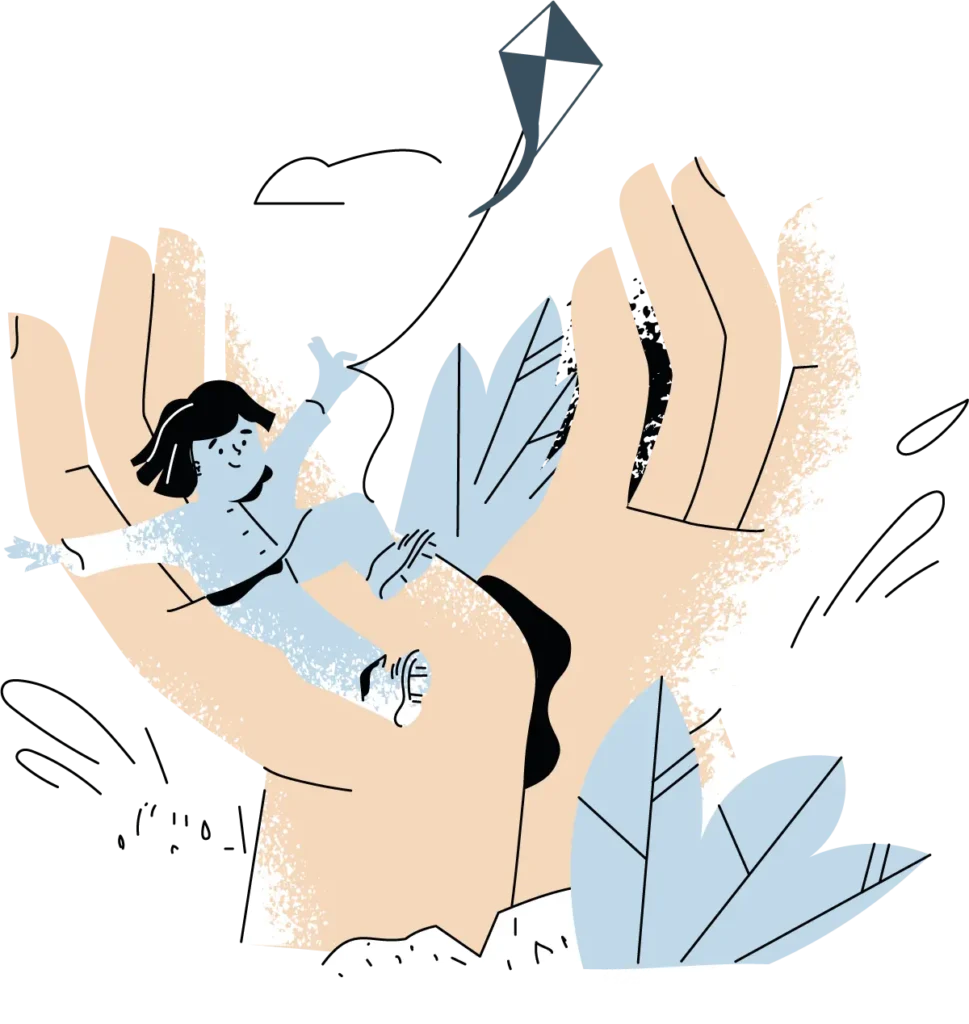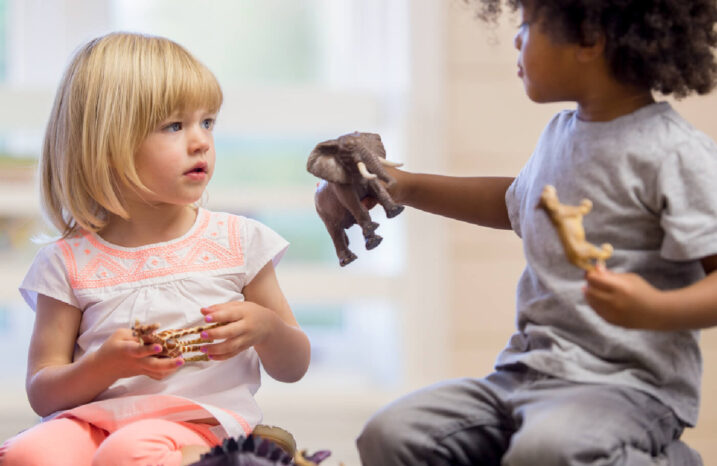What is Sharing and Showing in Childhood?
Sharing and showing in childhood is the ability for young children to connect socially by presenting their toys or other objects to others. Toddlers and young children may share objects of interest with their parents, siblings, teachers, and preschool classmates.
This skill is most important in the preschool years. Children are in the process of building social connections by observing other people’s reactions to toys and objects.
Sharing includes bringing toys or objects to another person, giving another the object while making eye contact, and waiting to see if the other person enjoyed what they are sharing.
Showing includes bringing the object to show another person, looking to see if they like it, and then smiling or offering facial expressions to share in the encounter before returning to play.
Symptoms of Poor Sharing and Showing in Children
- Doing their own thing: your child is happy, smiling, giggling but not really playing or enjoying time with you.
- Prefer own choice of activity: your child would prefer their own choices of activities or toys over playing with others
- Playing alone: your young child will engage with toys but is less likely to bring you something they think you will like such as a snack or a favorite object
- Bringing something and dropping it off: your young child brings you toys, snacks, or objects but hands them off without eye contact and without waiting to see if you enjoyed what they brought
- Using a parent as a comfort object or tool: your child clings to you but not to engage socially. Rather, the child is just seeking physical comfort. The child may be taking your hand or leading you, using you as a tool to reach for a cookie or get a toy off the shelf
- Showing more interest in a toy than the interaction: your child may be enjoying a book, board game, TV show, joke, or ice cream sundae, but they don’t care if others are enjoying this with them
Sharing and Showing Across Childhood Development
We want to see a young child bring and show things to a parent frequently, make eye contact and wait for your reaction, hoping to connect with you and share in your happiness.
Sharing and showing is much less relevant in older children. However, you may find that an older child shares and shows with others by offering comments and information about their day, noticing a show or movie they think a peer or family member would enjoy, or bringing a favorite snack to a friend on their birthday. In these ways, an older child or teen is socially connecting with others.
We focus more often on conversation and emotional connection when assessing social development with teens. Developing sharing and showing skills with friends or family is also a great way to connect socially.
Causes of Poor Sharing and Showing in Childhood
If a child fails to share and show as a toddler, or does this without eye contact or without waiting to see whether the friend or parent enjoyed the toy, snack, object, etc., it could be a sign of delays in social development. Autism Spectrum Disorder is often the primary cause.
Autism Spectrum Disorder
Autism is a disorder of social communication and restricted and repetitive behavior in childhood. In the case of autism, it is common for children with ASD to be more interested in toys and activities from their own perspective and to be less aware of the engagement and interest of others.
Because social engagement is so important in the early years, we look at reciprocal play, sharing and showing, and shared enjoyment. The critical feature of social reciprocity can be assessed with a younger child by looking at the quality of a child’s connection to others.
Children on the Spectrum can be loving, sweet, cute, intelligent, and fantastic, and you will notice that they are not taking in that social information and social connection in the same way. Sharing and showing are a part of young children connecting socially. When this skill is absent, it can indicate a developmental delay like autism.
Want to know if your child’s challenges are a sign of Autism Spectrum Disorder? Cadey courses are taught by licensed psychologists and walk you through the symptoms of autism and how they may present in your child. Sign up today.
What to Do about Poor Sharing and Showing in Early Childhood
We want young children to share and show objects with others to establish shared enjoyment and social reciprocity with parents, family members, and peers. These ‘DOs’ for working on shared enjoyment are great for a child who is not sharing and showing.
Here are some DOs for working on shared enjoyment
DO join your child in play with warmth, tickles, and physical touch. For many children with autism, it is easier for them to share the enjoyment with physical play first, and this kind of activity is excellent. Have fun yourself. Find time to laugh, and engage in physical touches like hugs or tickles (if your child likes this kind of touch, if not, always honor your child’s boundaries). Work to have fun together.
DO make eye contact and initiate shared enjoyment from your end with the toys and play your child loves. Be it gardening, baking, building Legos, or reading books, take an interest in a favorite for your child. Then, try to devote some uninterrupted time to engage in that activity with your child.
DO work to expand the shared enjoyment, slowly and comfortably bringing your child outside their internal world. We want your child to realize that it can be enjoyable to do things that others love with someone else. Expand to something larger or busier (if tolerated) like a Lego museum, the zoo for an animal lover, etc. You want to enter your child’s world and reach a shared enjoyment around a shared interest.
Then, you can transfer some of this learning to peer interactions with other children who share those same interests and passions that your child has. Plan to be actively involved in playdates and initiating the connection and cooperative play with your child and a playmate.
DO have a mix of interactions at home. Give your child downtime, time to relax, and engage in their own interest. Also have family time to play games, watch a movie or show together, share snacks, take turns and do activities that involve cooperation and shared enjoyment.
DO use timers. if you are having trouble getting your child to shift from one activity to another.
When to Seek Help
When your child is not sharing toys or snacks and showing you objects, start to look closely at their social skills.
- Is your child socially engaged with you or the toys?
- Are you a cooperative playmate or a comfort object?
- Are you saying things like, ‘He is just independent. He likes what he likes. He is so easy, he can entertain himself for hours.’?
If you are saying these things, see a psychologist who specializes in early child development and does evaluations of these skills. You can also see Child Find because young children are eligible for state-funded support and services and there is no harm in taking advantage of these programs.
Social skills can be hard to work on and brain plasticity in young children is really fantastic. If you can find an ABA therapist who uses Pivotal Response techniques, developed by researchers out of UC Santa Barbara, the Kagans, you can see great social progress in the use of socially directed language, social responsiveness, and social communication. Other similar models include Denver Early Start, and teachings from the MIND institute. Often for these services, you need a diagnosis from a testing psychologist.
A good BCBA (board-certified behavior analyst) can be life-changing for a family. These clinicians have seen children make massive progress with this kind of ABA treatment.
Professional Resources on Sharing and Showing
- Testing psychologist: to conduct an evaluation. A psychologist with expertise in childhood assessment can look at social skills, including shared enjoyment, cognition, language, and other areas like motor skills, executive function, or attention. An evaluation should result in a profile of strengths and weaknesses, any diagnoses that are relevant as well as prioritized recommendations for treatment
- BCBA and ABA therapy team: to help with behavior management. A Board Certified Behavior Analyst leads an ABA team that includes BCaBAs, line therapists called RBTs, and this therapy includes direct pivotal response treatment with your child as well as parent consultation and monthly team meetings for data review. This treatment has the most research to support its effectiveness with social symptoms like sharing and showing in young children ages 2-7
- Social group therapy: to work on social skills. With older children, a mix of cognitive-behavioral psychotherapy and social group therapy led by a psychologist, speech pathologist, or licensed therapist is recommended to help them work on their social skills
- Speech pathologist: to work on pragmatic (social) language and conversation skills with a child individually or in a group setting
- School psychologist: to support your child at school with social groups, individual support, parent consultation to help determine the best peer buddies or peer models, and consultation with a teacher to provide support in the classroom
- Child find: to evaluate a young child who is lagging in social skills. They do not diagnose autism, but they can test skill levels, provide free preschool and therapies and help you find testing psychologists in your community who can evaluate for autism
Similar Conditions to Sharing and Showing
- Social presence: the skill of being comfortable being around other children
- Cooperative play: the skill of playing cooperatively with other children instead of just parallel play (side by side); taking turns; allowing other children to choose games and activities too
- Shared enjoyment: the skill of sharing fun and enjoying interactions with family and friends, not just enjoying the toy or game or activity itself; enjoying the social interaction moment
- Reciprocal conversation: the skill of having conversations that include a lot of listening, sharing, asking questions, and allowing the other person to engage in the conversation
- Varied interests vs. Restricted: the skill of talking about varied interests may be somewhat absent in your child. When a child has interests related to a few very specific topics, psychologists call this ‘restricted interests.’ In boys, these unique interests tend to stand out more. In girls, their restricted interests tend to be more mainstream, like horses or dolls. With boys, you may see more unusual interests like air conditioners or mailboxes.
- Lacking pretend play: the skill of playing make-believe may be absent in your child. You may notice your child does not play pretend with toys or dolls. They may only use objects functionally, rather than making believe such as imagining a cardboard box is a rocket ship
Book Resources on Sharing and Showing in Childhood
Association for Science in Autism Treatment, to learn more about effective and research-based interventions for Autism www.Asatonline.org
Barton, Erin. Educating Young Children with Autism Spectrum Disorders.
Baker, Jed. (Retrieved 2017). Social skills books and resources for ASD.
Baker, Jed. (2006) Social skills picture book for high school and beyond.
Berns, Roberta M. (2010). Child, family, school, community: Socialization and support.
Gray, Carol & Attwood, Tony (2010). The New Social Story Book, Revised and Expanded 10th Anniversary Edition: Over 150 Social Stories that Teach Everyday Social Skills to Children with Autism or Asperger’s Syndrome, and their Peers.
Kroncke, Willard, & Huckabee (2016). Assessment of autism spectrum disorder: Critical issues in clinical forensic and school settings. Springer, San Francisco.
Koegel Autism Center, University of California at Santa Barbara.
Ozonoff, Sally, Dawson, Geraldine & McPartland, James C. (2014). A parent’s guide to high functioning autism spectrum disorder: How to meet the challenges and help your child thrive.
UCSB PEERS Clinic. https://www.semel.ucla.edu/peers
Trawick-Smith, Jeffrey (2013). Early childhood development: A multicultural perspective.


